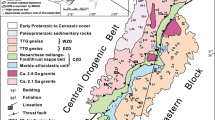Abstract
WILSON1 postulated, using faunal, tectonic and stratigraphic evidence, that the northern and southern parts of the British Isles were once separated by an ocean (the proto-Atlantic Ocean) which has since been destroyed by a continental drifting process in which the British Isles resulted from the welding together of land masses originally on different sides of the ocean. Following the stimulus of Wilson's idea and the possibility of plate tectonic theory providing an explanation for the continental movements, the geology of the central British Isles has been reappraised2–7 and the igneous, structural and stratigraphic features of the area have been related to the motion of lithospheric plates being thrust under continental masses as the continents converged.
This is a preview of subscription content, access via your institution
Access options
Subscribe to this journal
Receive 51 print issues and online access
$199.00 per year
only $3.90 per issue
Buy this article
- Purchase on Springer Link
- Instant access to full article PDF
Prices may be subject to local taxes which are calculated during checkout
Similar content being viewed by others
References
Wilson, J. T., Nature, 211, 676 (1966).
Dewey, J. F., Nature, 222, 124 (1969).
Dewey, J. F., Scott. J. Geol., 7, 219 (1971).
Dewey, J. F., and Pankhurst, R. J., Trans. Roy. Soc. Edinb., 68, 361 (1970).
Ziegler, A. M., J. Geol., 78, 445 (1970).
Bird, J. M., Dewey, J. F., and Kidd, W. S. F., Nature Physical Science, 231, 28 (1971).
Fitton, J. G., and Hughes, D. J., Earth Planet. Sci. Lett., 8, 223 (1970).
Powell, D. W., Scott. J. Geol., 7, 369 (1971).
Agger, H. E., and Carpenter, E. W., Geophys. J. Roy. Astron. Soc., 9, 69 (1964).
Pringle, J., The South of Scotland (HMSO, 1948).
De Bruyn, J. W., Geophys. Prospect., 3, 1 (1955).
Charlesworth, J. K., Historical Geology of Ireland (Oliver and Boyd, London, 1963).
McLean, A. C., and Qureshi, I. R., Trans. Roy. Soc. Edinb., 66, 267 (1966).
Powell, D. W., Scott. J. Geol., 6, 355 (1970).
Macgregor, M., and Macgregor, A. G., The Midland Valley of Scotland (HMSO, 1948).
Greig, D. C., The South of Scotland (HMSO, 1971).
Aeromagnetic Maps for Great Britain and Northern Ireland, published by the Geological Survey of Great Britain.
Anderson, J. G. C., Trans. Roy. Soc. Edinb., 61, 419 (1947).
Gravity Map of Northern Ireland, published by the Geological Survey of Northern Ireland.
Dewey, J. F., and Bird, J. M., J. Geophys. Res., 76, 3179 (1970).
Author information
Authors and Affiliations
Rights and permissions
About this article
Cite this article
GUNN, P. Location of the Proto-Atlantic Suture in the British Isles. Nature 242, 111–112 (1973). https://doi.org/10.1038/242111a0
Received:
Issue Date:
DOI: https://doi.org/10.1038/242111a0
This article is cited by
-
Antibody-dependent cell-mediated cytotoxicity
Survey of Immunologic Research (1983)
-
Pre-Palaeozoic basement of the Scottish Midland Valley
Nature (1976)
Comments
By submitting a comment you agree to abide by our Terms and Community Guidelines. If you find something abusive or that does not comply with our terms or guidelines please flag it as inappropriate.



